-
Posts
513 -
Joined
-
Days Won
107
Content Type
Profiles
Forums
Events
Shop
Posts posted by Kiwi
-
-
I've been through so many, they all seem to have warped tops due to 6 string bracing...I've heard good things about Alvarez and I played a new one which was great. But the only one I had access to purchase also had a bent top...
-
On 07/10/2025 at 18:15, Crusoe said:
Or are your fingers too big?

 23 hours ago, EdwardMarlowe said:
23 hours ago, EdwardMarlowe said:
I think it might be an age thing. I'm getting increasingly grumpy with technology this last couple of years...Yes to both, not helped by intermittent focus in my eyesight and a reluctance to take my reading glasses everywhere in case it brings on mid life crisis.
-
 1
1
-
 1
1
-
-
On 25/09/2025 at 00:37, Iain Douglas said:
Pleased to be here and look forward to ‘ ‘meeting’ you all in the virtual world.

Welcome aboard Iain
-
I bought an Xotic XW1 wah about 7 years ago and now Paul Jackson Jr and Steve Lukather are using them. Very versatile wah but they do take up a bit of space. If you are looking for just classic tones and smaller foot print then a mini Crybaby is the default option.
-
Acoustic? There's quite a drop off in quality within your price bracket. The necks are less reliable, the guitars aren't set up properly, frets need levelling, the woods are dried too quickly and can warp as they really season. I would suggest bumping the price up a little and go second hand. That way any faults are easier to spot. I have a soft spot for Yamahas as they are usually pretty reliable but Alvarez, Guild and Taylor are also worth considering.
-
On 22/08/2025 at 02:30, alpro said:
Hello everyone,I've just joined cause I like fixing guitars old and newand picking up info on them. I don't play, but am learning and it surprises me just how many people love guitars,
Welcome alpro - got any fixin' stories?
-
On 23/08/2025 at 09:17, tauzero said:
AIUI that's why John Hall and the Rickenwaffe rabidly enforce trademarks, because if they don't then the trademark could be lost.
They can be contested, yes. And potentially lost. Back in 2021 Fender tried to trademark the stratocaster body shape but the application was denied after a load of other guitar makers appealed including Schecter, Dean, ESP, Suhr and others. (Not Charvel though, because they are now owned by Fender.) But basically the collective contested on the grounds that the strat body shape had been widely copied over the last 50 or years and Fender didn't object the. So why try and trademark a property now that they had no problem sharing before?
Incidentally, public Rights of Way operate on the same basic use-it-or-lose-it principle -
PRS SE of almost any description although my personal preference is the hollowbody first followed by the Swamp Ash HSH.
Having said that, when I fancy a new guitar, I make one. This might sound like a dream but its happened every year for the last few years now as I've developed confidence and a couple of them are REALLY good. However I'm now caught between running out of space and not wanting to sell any.
Honourable mention for the Ibanez AWD83T, amazing guitar for the price used. One of those gems that deserves more recognition once the neck pickup has been swapped out for one from the more modern Artcore range.
-
 1
1
-
-
On 05/08/2025 at 01:49, EdwardMarlowe said:
I'm not up on US tm law, but across UK and rest of Europe, a tm is only valid if in use... It'll be interesting to see how it shakes down in the courts.
Trademarks don't require 'use' because they are validated through rights assigned at registration. They have to be renewed periodically though and trademarking ideally should be enforced too, in order to safe guard against applications to cancel (due to lack of enforcement action). Unlike patents, trademarks can exist in perpetuity so long as they are renewed.
-
On 26/07/2025 at 21:06, StairliftToHeaven said:
Hi!
Same as everyone else I guess. Too many guitars...ambitions to trim down the collection...then go and buy another one

You have just described the last 4 weeks for me. I'm up one self build with another in the works and two opportunistic bass purchases. I have officially run out of space and now have to set a rotating display on my hangers of the ones I don't play so often. Welcome brother...
-
On 29/06/2025 at 17:22, KingBollock said:
The other thing I want to do is change the pickups. I have seen a set that has a mini, hot rails humbucker for the bridge and a black chrome single in the neck position. I want to replace all the electrics*. I want a 4 way blade switch for:
Switch Positions
1) bridge
2) neck + bridge (parallel)
3) neck + bridge (series)4) Neck
Plus a push pull pot for splitting the hot rail coils.
A seymour duncan 'semi super switch' would give you an extra position which could be wired to combine coils from each pickup.
-
On 25/06/2025 at 17:28, EdwardMarlowe said:
This one is interesting because the Klon hasn't been in production since 2008.
This might be the crux of Behringers defence. If Klon haven't been selling them and making profit, Behringer might say how can Klon claim damages when they haven't been losing money...and the Behringer circuit is in all likelihood an emulation rather than a copy knowing that timbre can't really be copyrighted or trademarked.
In the PRS vs Gibson battle, Gibson's case hinged on there being the potential for confusion between the PRS single cut and Gibson LPs which didn't really stand up to the scrutiny that was eventually applied. Klon's lawyers may come back and say 'copyright or trademark infringement' based on the potential for confusion (depending on what is actually registered as a trademark)
On 25/06/2025 at 23:45, KingBollock said:I suppose, what I could do, is build my own
Or get a Digitech Bad Monkey :lol:
Yeah I went there.
-
 1
1
-
-
I use a Seymour Duncan 'semi' super switch, I can change position 3 from middle pickup to bridge and neck.
-
 1
1
-
-
Had to do a lot of routing to get the bridge located properly including plugging and redrilling one bridge post 1mm further way. The wiring was a challenge, I spent three days of eliminating possible causes to arrive at only one conclusion, the pickup selector switch was faulty. My midboost preamp didn't work and I wasn't going to spend a week trying to troubleshoot it, so I bought one only to discover that the guy who build it didn't include separate earth and -9v wires. So had to jury rig something up to provide the output socket with an earth connection, the boost is definitely warm but it lacks the glassiness I expected. So I have on order a genuine Demester Fat Boost (Tyler style) and at some point I will probably wire the switches so they are series, phase and parallel. Although they were fiddly to solder as well.
However, after a fret levelling and proper set up, it plays very nicely and has more sustain than my other two strats. I have no idea why. It's quite a warm and loud sounding guitar as well acoustically.More aging is needed on the sides and back but I have other things to attend to in advance of being in the UK next month.
-
 2
2
-
-
Firewood: Any Gibson bass from the eighties. I don't care about flammable potential, I'm performing a public service here godammit!
Weapon: Steinberger GL2 - wood is just not up to the task and original Steinbergers can really take a beating.
Player: Probably the guitar currently being built for me if it turns out to be everything expected. Otherwise #1 MSG with the Armstrong pickups. -
On 12/07/2025 at 08:23, Jensen said:
Haha sorry
 I play electric usually with quite a bit of gain, I've wanted to try picking up some very basic solos and lead part just from songs I like, at the moment I'm attempting to learn Paranoid by Black Sabbath as I'd heard it's a good place to start in that genre. A lot of the time when I have to bend or vibrato I find I'll manage to get the next string across to ring out. I'd assumed it would be usual to start with but wanted some technique pointers just to get me headed in the right direction. Thank you
I play electric usually with quite a bit of gain, I've wanted to try picking up some very basic solos and lead part just from songs I like, at the moment I'm attempting to learn Paranoid by Black Sabbath as I'd heard it's a good place to start in that genre. A lot of the time when I have to bend or vibrato I find I'll manage to get the next string across to ring out. I'd assumed it would be usual to start with but wanted some technique pointers just to get me headed in the right direction. Thank you .
.
What is the fingerboard radius on the guitar you play? Radii of 10" or less often lead to strings choking on bends. 12" or more should be fine though.
-
On 25/06/2025 at 17:32, EdwardMarlowe said:
Wouldn't surprise me. The older I get, the more I realise 99% of the electric guitar market is about selling branding an intangibles far over the actual, physical product. It does seem to vary by location, though: players in the US on average still seem to be much more likely to be emotionally invested in the idea that a guitar made in the USA *must* be superior, or is somehow otherwise "the real thing". Which I suppose shouldn't be surprising given that's where the electric guitar boom started, and so there's a sense of "loss" that those aren't dominant in the market any longer - as opposed to being "only" another import product as they are for us in the UK.
Absolutely, it's about selling dreams...as in 'buy this and get closer to living the dream'...whatever that dream is.
-
 1
1
-
-
On 04/07/2025 at 00:37, ezbass said:
Yep! Therein lie the important chord tones, which will add flavour to your soloing.
Mostly thirds.
-
Look at barre chord shapes and use those notes as a guide to what to play, then experiment with different positions up and down the neck. Then, if you're brave, try it with inversions and THEN with modes. See how far you can push things without it sounding irrelevant.
-
 1
1
-
-
OK I think I've reached the end of the road with this one. Or at least I've gone as far as I can...
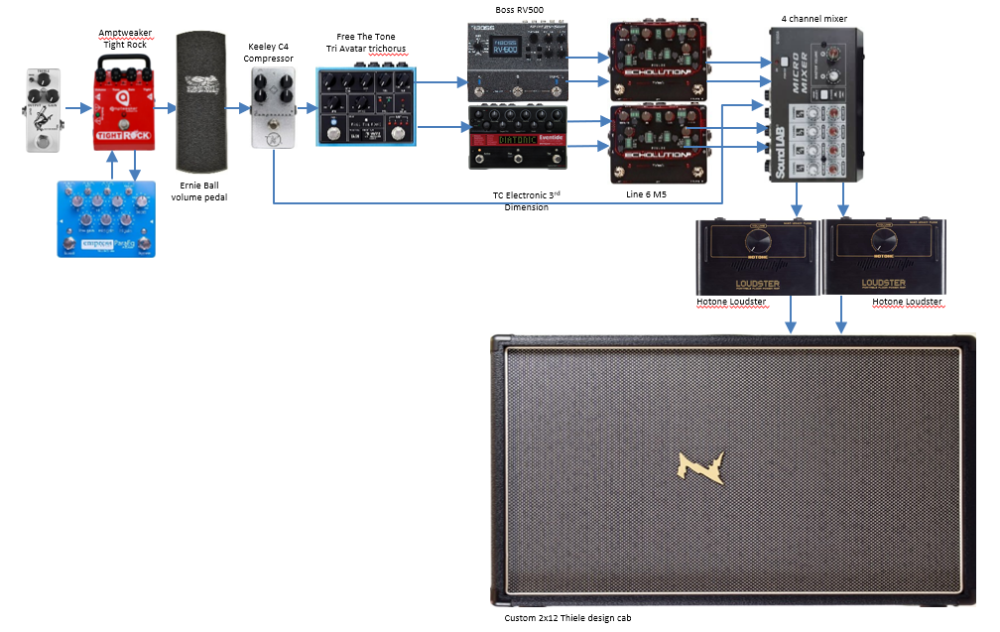
The Ernie Ball VP Jr arrived and works great although there isn't enough space on the already quite generous pedal board for it. Over the weekend, I also discovered someone selling Eventide Pitchfactor for about 230 quid online and so pulled the trigger because it does Eventide Harmoniser detune. So that has replaced the TC Electronic 3rd Dimension. And a second Pigtronix Echolution arrived as well but I may have actually over cooked it a little because just one can handle stereo AND both the RV500 reverb AND the pitchfactor have delay as well...hmmm. Slight buyers remorse perhaps. The only thing left in the set up is another pair of Loudster power amps which I'm in no hurry to buy right now given the Marshall power amp does the job adequately for practice purposes. I'll post a pic of the actual pedalboard once I've finished the re-wiring. Now I should probably go and learn some songs...
-
 1
1
-
-
Like countless others outside the UK, I've been drawn to and subsequently obsessing over the clean tones that were achieved by in demand US session guitarists in the eighties and early nineties. While Michael Thompson was perhaps best known for his clean tone, Dann Huff appeared on countless Top 10 recordings that featured his lush stereo swells including tracks by Peter Cetera, Amy Grant and others.
Part of that sound was down to his rack of effects often involving a Mesa Studio preamp into a Songbird trichorus, then stereo with one side going through an Eventide Harmoniser and Roland SDE3000 or Lexicon delay, the other side going through a Lexicon reverb and then another delay. However another part of his sound involved a highly modified 64 strat c/- Jim Tyler which featured Seymour Duncan STK2 pickups in middle and neck plus a JB (SH4) humbucker in the bridge AND...a Tyler mid boost circult which also sparkled up the presence a bit as well. So I'm going to recreate his 64 strat, including making the midboost circuit.
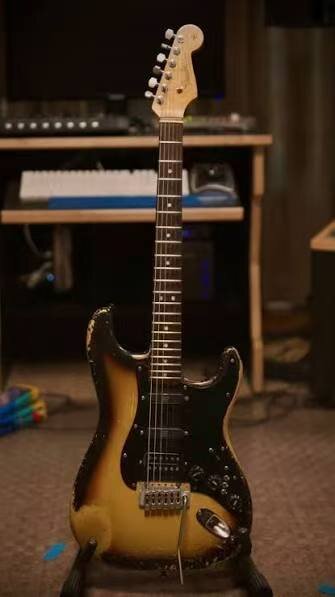
I've nearly assembled all the parts, however I had to trash the cheap neck that was going to be used after I discovered that it had warped into an S shape and whoever made it cut the fret slots at ninety degrees to one side of the fingerboard...DOH. Luckily it was only 30 quid but still...a replacement, fully painted, is on the way. Also, the pickup seller sent a TB5 custom instead of the TB4 (trem spaced version of the SH4) but the replacement has arrived. And finally, the series parallel pickup switches that arrived were on-off-on when I ordered on-on. So waiting for the replacements to arrive from a different seller.-
 1
1
-
-
And...I just tried this set up with pedals and while the reverb before delay goes against all conventional wisdom, it provides the smear that I was after. The set up still needs a direct out from the gain pedal to the mixer though for definition. A Line6 M5 from the bass rig is being used temporarily as the second delay and a TC Electronic Dimension D is providing the detune. It retains more definition than the Zoom MDC70S patch with +/-7 cents. I've also parked the Mosky Silver Horse in front of the Tight Rock for extra mid boost. It appears the Tri Parallel mixer is no longer needed here.
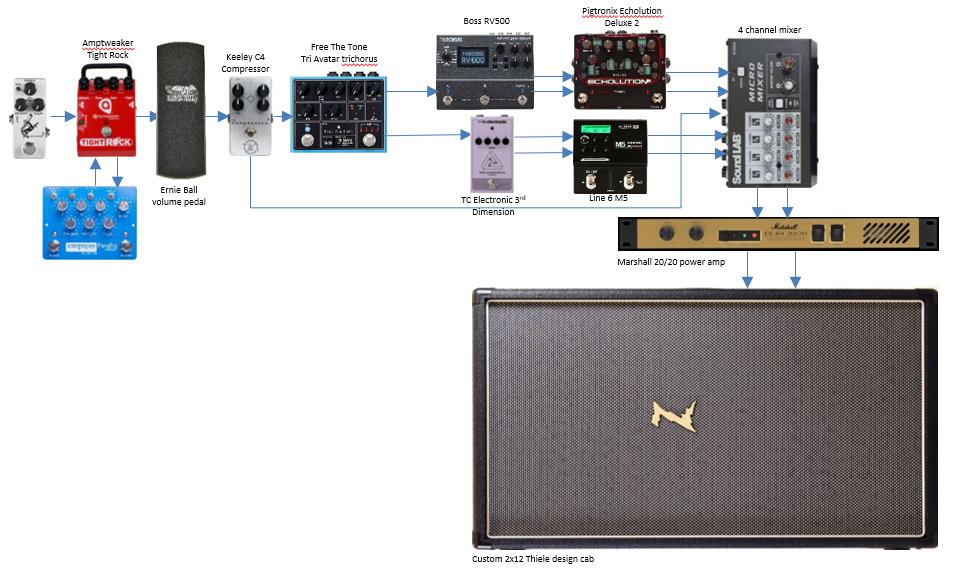
So now, just need to find a second MIDI capable delay and a decent volume pedal and we are going to be there more or less, unless I decide the detuning/Dimension D needs to be MIDI capable as well.
-
Just caught a video follow up specifically on Huff's chorus settings with input from Mason at Vertex. Mason shared this diagram from someone who was involved with Lukathers 1984 rig and it throws everything I had assumed so far, about how the parallel signal processing was set up, out the window. This is after I've already cut the pedal board connections to length..! This shows that the trichorus acts like a sort of signal conditioner, splitting the signal into stereo and sending each side of the stereo output separately to detune and reverb, then to mono delays (presumably to dotted eighth and quarter notes) on left and right. I'm going to have to experiment with this and rerout all the connections.
Also, while at least one YTer has stated they think most of the distinctive lushness comes from a Yamaha SPX90 symphonic patch, Lukather (and probably Huff if this latest news is credible) both used an Eventide for the detune. So that puts the Pitchfactor and a whole host of other detune pedals like the GFI Systems Synesthesia into consideration. The Synesthesia does Dimension D, detune and trichorus and two effects at the same time BUT, it's at least the same cost, if not more, of any two of those pedals together. So the extra cost buys versatility (if multiple kinds of modulation are needed) or board real estate but it's a little overkill where trichorus is routed separately to the detune.
-
Hey, welcome aboard. If you have any questions, feel free to post them.


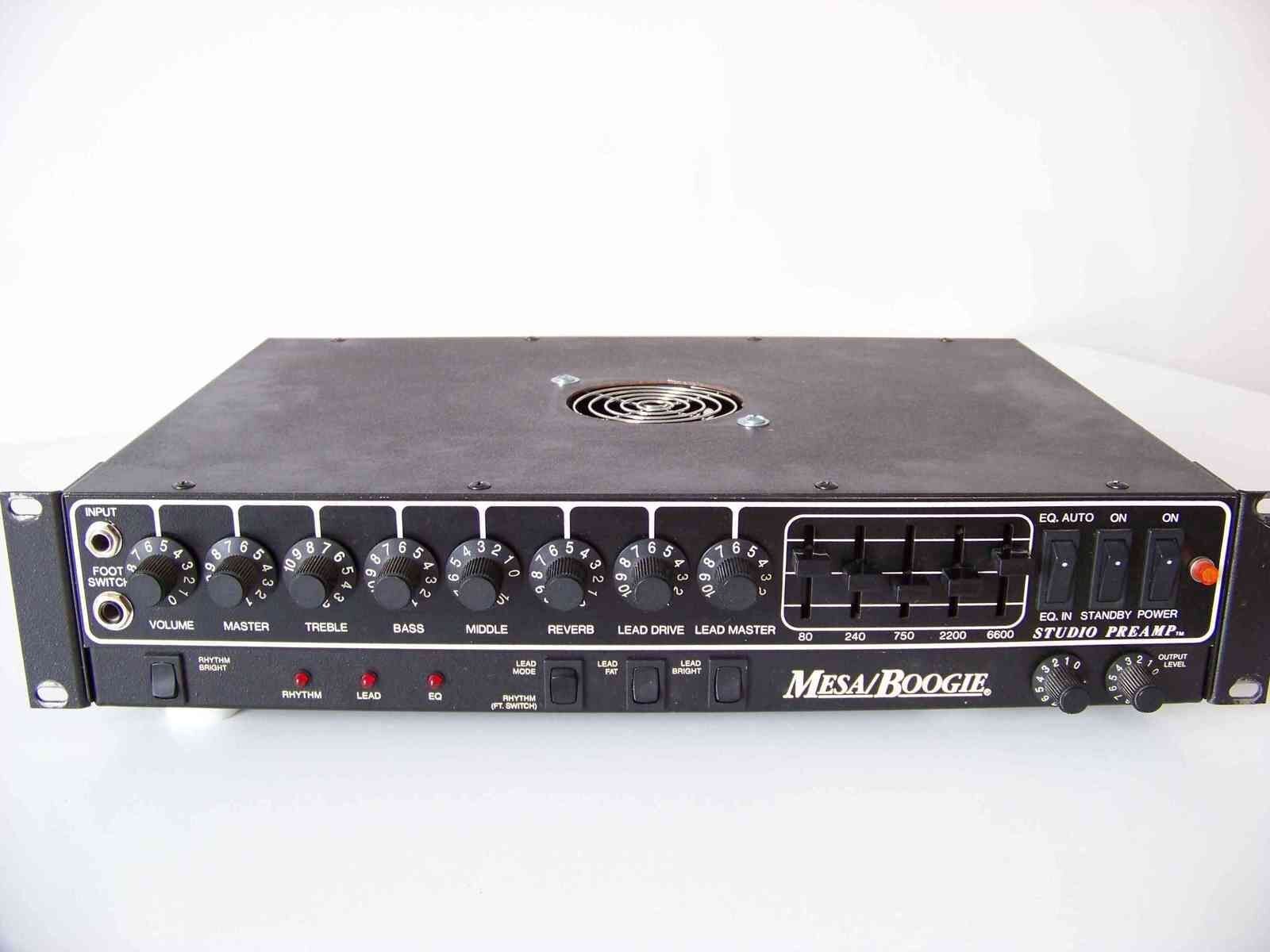
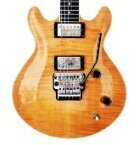
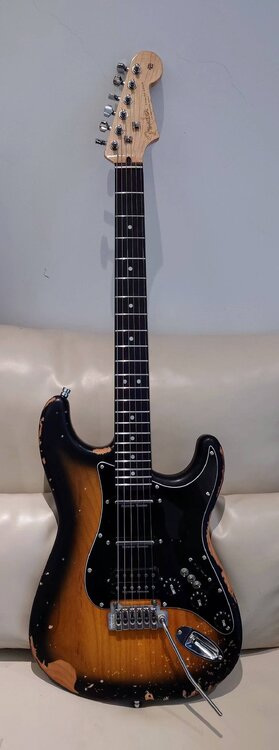
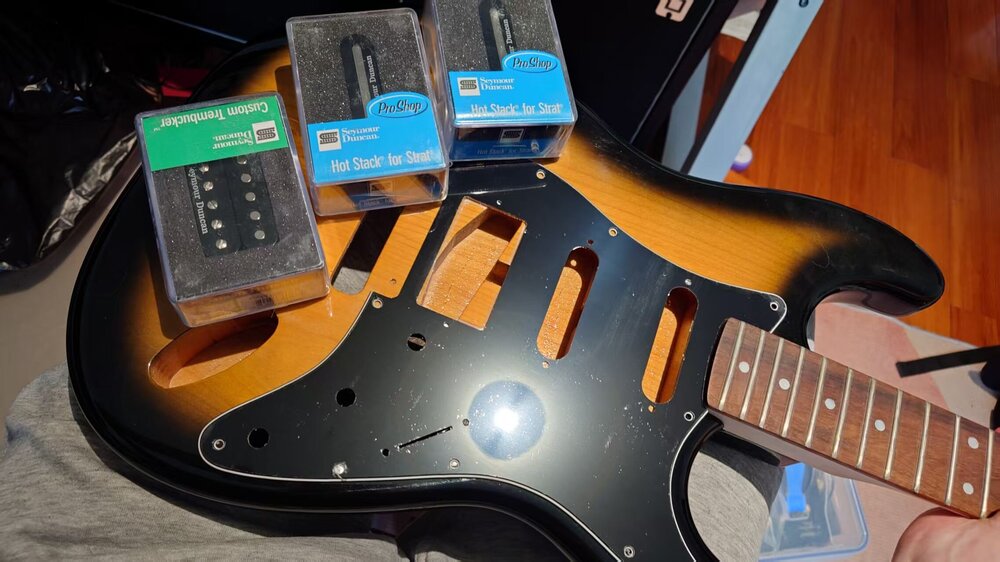
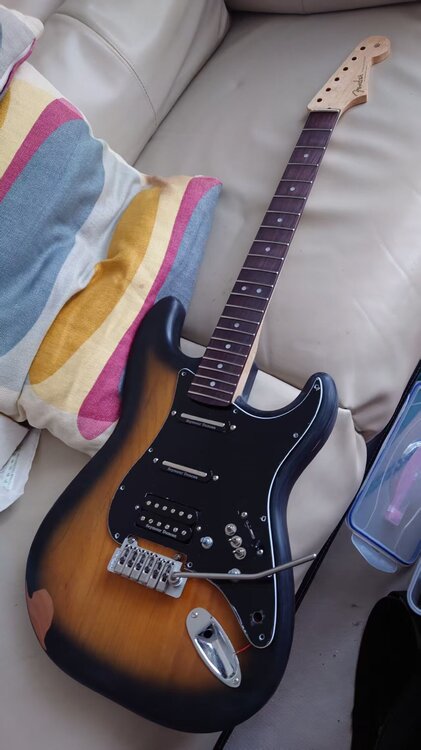
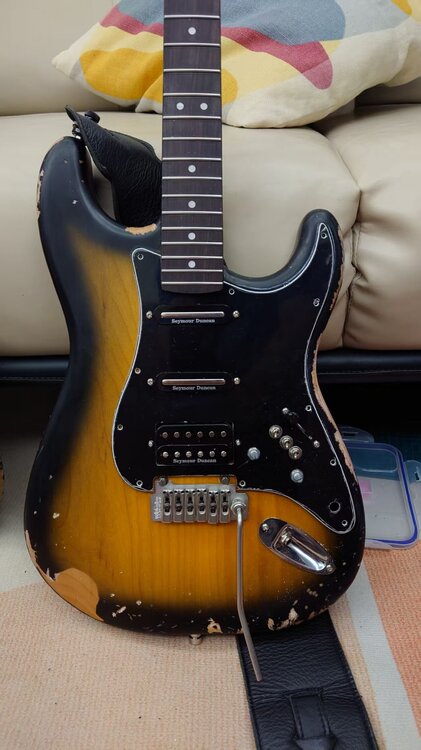
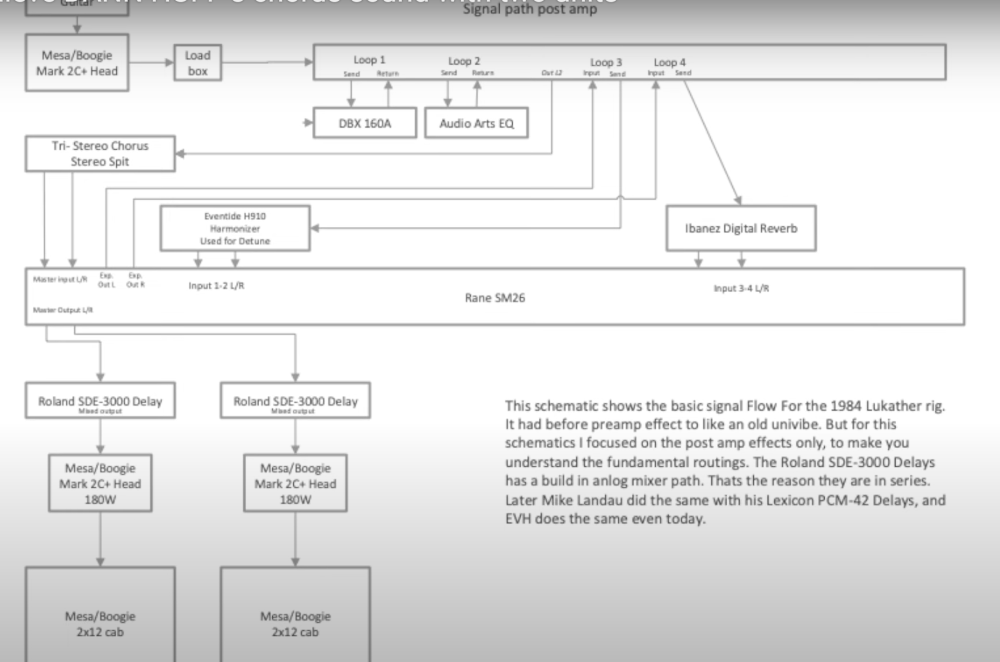
You will be shocked
in General Discussion
Posted
A 12 string without a warped top seems a very rare thing these days. I would go for a Rainsong but the used prices are a little nuts. None of the composite acoustic guitar makers here in China do a 12 string.